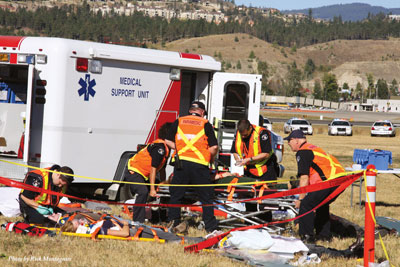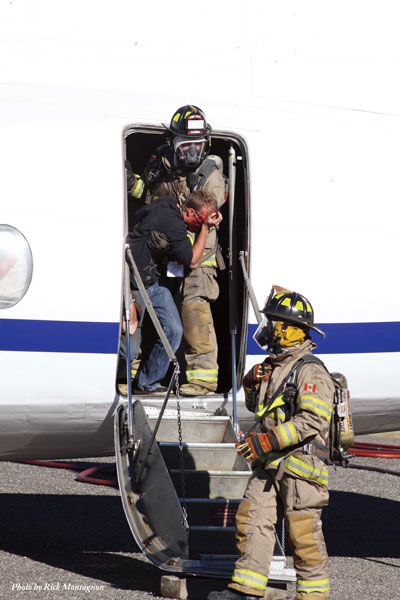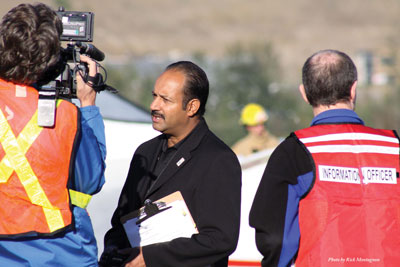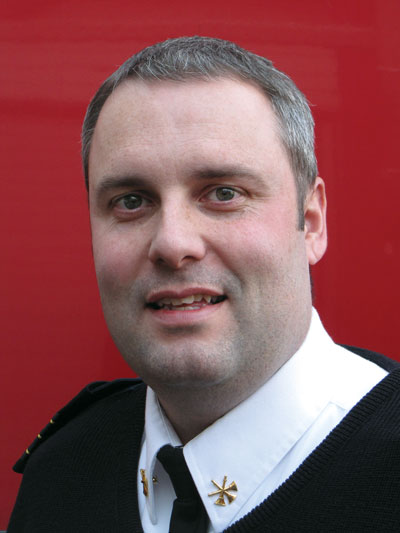
Features
Emergency & disaster management
Hot topics
Emergency preparedness takes off
Sept. 13 was a milestone day for emergency preparedness in the Central Okanagan region of British Columbia.
February 1, 2013
By Jason Brolund
Sept. 13 was a milestone day for emergency preparedness in the Central Okanagan region of British Columbia.
 |
|
| Paramedics treat injured passengers during a mock disaster exercise in British Columbia in September. Co-ordinators brought together more than 300 participants from 40 agencies.
|
At 0630 hours, fictional flight Unity 123 departed the Kelowna International Airport. Like any of the other 62 flights that do the same each day, Unity 123 left without attracting any extra attention. What followed tested and put into practice the effectiveness of the overall community response to a major aircraft incident.
Shortly after departure and without explanation, the aircraft squawked code 7500 – it had been hijacked.
Security plans at the airport were put in motion. Across the country, and in co-operation with partners from the United States, security and transportation agencies stood up in response to the threat. As the airplane silently circled the region, participants asked: Is this our issue? How should our region prepare? What should we, as emergency services, do in response?
Media flooded the regional fire dispatch centre with calls. Someone on board the aircraft tweeted that there had been an explosion and the plane was going to crash. Radio communication was established – the pilots requested an emergency landing.
 |
|
| The level of engagement by all agencies in preparation for this exercise has been very gratifying and the exercise co-ordinators – Neil Drachenberg, from Kelowna International Airport, and Jason Brolund, from the Kelowna Fire Department – deserve a lot of credit. The lessons learned from the exercise will assist in training and refining the community’s response plan and ensure that, should an incident occur, the public are given a highly proficient and co-ordinated emergency response. – Sam Samaddar, YLW airport director |
Under federal legislation, airports are required to exercise their disaster plans every four years. Under provincial legislation, local governments must exercise their emergency plans annually. Starting from a suggestion at a joint emergency services meeting in early 2011, officials from the Kelowna International Airport (YLW), Kelowna Fire Department (KFD) and the Central Okanagan Regional Emergency Program (managed by KFD) were challenged to plan and execute a joint full-scale disaster exercise. Early on, it was recognized that scenario development, logistical preparation and evaluation support were going to be required. TascMet Clinical FX was engaged to assist with the creation and delivery of a realistic, custom-designed disaster scenario, including high-fidelity casualty simulation.
Over the next year, interest built around the event and agencies met to learn about how they could participate. When the dust settled, a group of 40 agencies, including federal, provincial and local governments, media and the private sector, had committed. In addition, both the University of British Columbia and Interior Health (the regional health authority) would conduct their own full-scale exercises. A set of exercise objectives was proposed and accepted by the agencies.
The exercise objectives of Operation Unity 2012 were to:
- exercise and evaluate capabilities of the Regional Emergency Operations Centre (EOC)
- exercise YLW security and operational plans to meet Transport Canada’s legislated requirements
- exercise regional emergency response agency capabilities and operational plans
- exercise support relationships with regional and provincial co-operating/assisting agencies
- exercise support relationships with regional and provincial governments
- deliver a final report and historical record to all participating agencies
Following the initial planning conference, each agency was charged with determining and sharing its overall exercise objectives. What resulted was a list of several hundred individual objectives that would guide the development of the exercise scenario over the next year.
The design team was led by Neil Drachenberg, airport safety and security manager, and Jason Brolund, deputy fire chief and regional emergency program co-ordinator. Funding for the exercise was jointly provided by YLW and the regional emergency program. The exercise organizers were fortunate to benefit from one of the final awards of federal/provincial funding supplied under the Joint Emergency Preparedness Program (JEPP).
As the exercise day drew closer, the training needs of all agencies were evaluated and a training program leading up to exercise day was developed. It was agreed that the Regional Emergency Operations Centre (EOC) would play a key role in the response to the event and, as a result, eight one-day EOC Fundamentals training sessions were conducted in order to introduce and refresh EOC training to exercise participants.
With three months remaining, a table-top exercise (TTX) was conducted to bring together all the agencies that were participating. The goal of the TTX was to step through the major disaster scenario, working out the issues as the scenario progressed. The Okanagan campus of the University of British Columbia (UBCO) was generous in providing a venue to host more than 100 participants in the TTX. With the room divided in two – emergency responders (site) on one side and site support agencies (EOC) on the other – the groups worked together to respond to a major incident. This event was deemed a great success as it served as a way to demonstrate to participants the need to constantly update and test their emergency planning, provide a training opportunity and develop momentum for the live exercise scenario.
With less than one month until the exercise day, a master events list (MEL) was created. This would be the script for the exercise day and needed to contain all events and actions that would take place, including inputs that would be delivered to exercise controllers at each of the eight exercise sites across the region:
- YLW – airport training ground
- YLW – airport emergency co-ordination centre (ECC)
- UBCO campus (EOC)
- Farm site in Glenmore Valley, B.C. (animal evacuation)
- Regional EOC
- Regional fire dispatch centre
- RCMP Operational Communications Centre (OCC)
- Kelowna General Hospital
The MEL would need to outline a realistic scenario in enough detail to ensure that all exercise participants’ objectives could be met, while keeping everyone engaged. In the end, the MEL spanned 29 pages and more than 100 injects into the disaster exercise. Separate communications, logistics, transportation and media plans were developed to address specific issues in these areas. On the day of the exercise, the MEL was printed in large format and posted at the various sites – forming one of the most popular areas for exercise observers to check in on the progress of the event.
The design team made a conscious decision to use subject matter experts as evaluators to provide an independent and objective assessment of the exercise. While each agency was responsible for assessing the performance of its own personnel, these experts, who were invited to comment as formal evaluators, hailed from:
- City of Kelowna
- B.C. Ambulance Services (EMS delivery agency)
- Emergency Management B.C. (provincial emergency program)
- FORTIS (gas/electric utility)
- Interior Health B.C.
- Kelowna Fire Department
- Sea Tac International Airport – Port of Seattle Fire Department
- Prince George Airport Authority
- RCMP
- Regional District of Okanagan-Similkameen
- University of British Columbia (Okanagan Campus)
Feedback from these agencies was critical in evaluating the success of the event and compiling lessons learned and recommendations for future improvement.
A concerted effort was made to ensure full and active media participation from the outset of the initial planning, recognizing the key partnership role that the media can play. Reporters were invited to participate in the exercise as mock media, which allowed them full inside access to the entire exercise. This allowed reporters to see the details up close and to build an understanding around the intricacies of managing and responding to major emergencies. As a result, the exercise was extensively covered by print, television and online media.
An observer’s plan was established for VIPs, including elected officials, emergency officials from other jurisdictions and senior executives. Shuttle buses transported these guests. Liaisons at each site provided tours and commentary about the exercise. Elected officials were briefed and played a role in declaring a state of emergency during the event.
But, even the best laid plans are subject to change. On the afternoon of Sept. 9, with just four days remaining until the exercise, a major urban interface fire struck the Central Okanagan region. Under a mutual-aid agreement, every fire department in the region sent apparatus and manpower to fight the rapidly expanding fire that claimed four homes. The regional EOC was activated to support the evacuation of 1,550 residents from the community of Peachland, B.C.
 |
|
| Reporters were invited to participate in the Operation Unity exercise as mock media. As a result, the event was extensively covered by print, television and online media.
|
Many of the agencies and individuals participating in the exercise were now directly committed to fighting the fire and supporting emergency response efforts and evacuees. Many of the same facilities and resources that would be used on exercise day were now committed to emergency response.
The exercise team set a 24-hour deadline to determine if Operation Unity would proceed and, following some tense moments, we were able to send the last of the evacuees home just as the deadline passed. Following consultation with the unified commanders of the incident, it was determined that the value of the exercise was too high not to go ahead. The exercise would proceed. We were able to take advantage of having some facilities already set up, but many participants stepped back following a gruelling 72-hour response. While we worried that this would affect participation, the actual reaction was that people who had originally not been part of the emergency response participated and gained valuable experience.
Sept. 13 dawned clear, warm and fire-free in the Central Okanagan. As exercise participants began to muster at various locations across the region, preparations had already been underway for several hours. Student volunteers from the UBC fine arts program had been up all night, having realistic moulage applied and learning about the roles they would be acting out for emergency responders.
Finally, shortly after 8 a.m., the hijacked plane was on final approach back to the airport. As it returned, it made a low pass over the city, leaking fuel, hydraulic oil and parts across a wide swath of the community, including the university campus.
In rapid succession:
- A fully loaded 737 crashes on the YLW airfield.
- Telephone circuits are overloaded and callers cannot place phone calls.
- Emergency responders converge from across the region.
- Regional EOC is activated.
- Rumours spread via social media.
- Widespread fuel contaminates populated areas and animals.
- Casualties are seen fleeing the area on foot and in personal vehicles.
- A hijacker is identified and apprehended.
- Media and family converge on the incident site.
- The airport is closed.
- The university basketball team is reported to be on board the aircraft.
- 30 victims are transported to hospital.
- Deceased are transferred to the coroner.
- Press releases are issued.
- A media briefing takes place.
When the exercise concluded, 306 participants from 41 agencies had tested all aspects of the regional emergency plan from the initial response; to the transport of victims to the hospital; to the evaluation of communication and interaction among health and educational institutions, utilities and private businesses. These agencies demonstrated that they were able to respond to a major disaster and make it look like just another day at the office.
However, not everything went well! A bus transporting observers had been filled with smoke when it broke down. A volunteer acting as a casualty had an authentic medical emergency and another had been left with no pants following a swift removal by an engaged emergency responder. But this was to be expected, and contributed to the success of the exercise. Had everything gone perfectly, there would have been no lessons learned.
Immediately following the event, a lunch and debriefing session was held at the university campus. Things that went well or that could have been improved upon were compiled into a comprehensive after-action report. A survey was conducted of all participants to further gather their impressions of the event.
Operation Unity was deemed a tremendous success.
The major strengths identified during this exercise represented recurring themes in three areas:
- human resources – group dynamics and operating culture
- communication and co-ordination – inter- and intra-agency co-ordination
- organizational structure and processes – established functional plan and processes
The after-action report also highlighted aspects of the same three areas for improvement:
- human resources – front-line responsiveness and resources
- communication and co-ordination – technology and equipment
- organizational structure and processes – training and learning
Seeing this process through from start to finish was tremendously rewarding. I encourage emergency managers and fire service leaders to challenge your community to host a disaster exercise to test your plans, training and response capabilities. What will result is a series of new contacts and strengthened relationships. It will make your organization better equipped to respond, regardless of the emergency.
Please contact me for more information about our exercise. If you are planning a similar event, we are happy to share our materials.

|
|
Jason Brolund serves as deputy fire chief with the Kelowna Fire Department in Kelowna, B.C. He has been involved in the emergency services for the past 18 years as a firefighter, paramedic, dispatcher and fire inspector. He manages the regional fire dispatch centre and the regional emergency program for the Central Okanagan. He recently co-ordinated Operation Unity 2012, a full-scale disaster exercise involving over 300 participants from 40 agencies.
Print this page